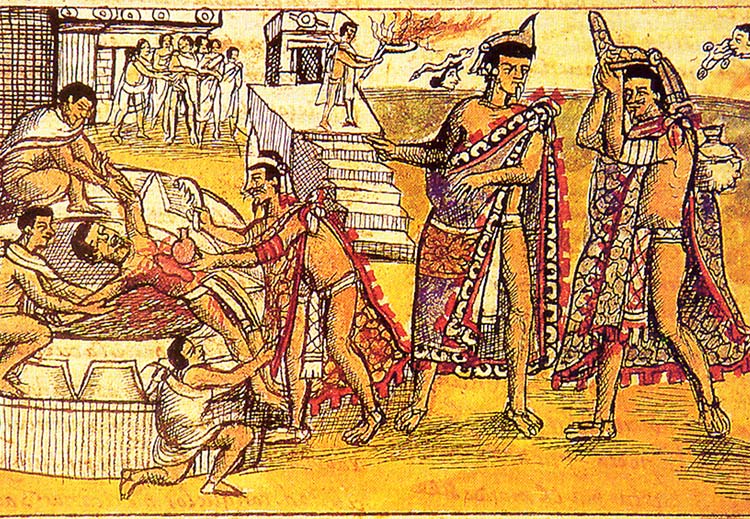Aztecs
Aztec mythology is of great interest. In particular, the reverent and incredibly respectful attitude towards death reflected in it.
One of the most characteristic features of the Aztec religion is sacrifice, primarily human.
Bringing human sacrifices to their gods, the Aztecs believed that they were maintaining the world balance, providing the gods with servants and warriors.
It is known that cremation was widespread among the Aztecs. As a rule, before burning, the dead were dressed in the best expensive clothes, tied so that they squatted, and wrapped in cloth.
Rulers and nobility were buried in stone tombs. In some cases, a person was buried or burned with a live dog.
The Aztecs believed that the dog would be a useful guide in the underworld.
Pogre traditions
In the mouth of the deceased, they put crushed corn and some jade beads, which were used as money.
Unlike the Greeks, the dead Aztecs needed money so that a person could buy something to eat for himself in another life.
The commoner was buried under the hard earthen floor of his house, along with his everyday things; if it was a fisherman, then nets and harpoons were laid with him, if a warrior – a shield and a spear.
Everyone put pots with food and drink in the grave.
The heroes who died in the war ended up in the so-called Eastern Paradise or the House of the Sun.
There were gardens all around, and the warriors devoted all their free time to sparring.

After spending four years in the House of the Sun, the souls of the warriors returned to the world of the living in the form of hummingbirds or butterflies.
Also, women who died during childbirth were seen off with great honors. Their souls went to the Western Paradise or the House of Grain, where they were already transformed into goddesses.
Their souls also returned to earth after four years – sometimes in the form of moths, and sometimes – in the form of demons and spirits, bringing misfortune to those who see them.
For those who died in other ways (suicide, lightning strike, illness, etc.) was the realm of Tlaloc, the god of water and rain. If the bodies of the soldiers were cremated, then those leaving for Tlaloc were buried.
Together with the body, a dry branch was placed in the coffin of the deceased. After burial, it should have turned green over time. The kingdom of Tlaloc is the land of eternal spring and prosperity.
People who lived to old age or died naturally and could not count on going to heaven were transported to the underworld of the Dead, or Mikltan. This place was far to the north, and the god Mictlantecuitli ruled there.
Requirements
It was required to go through eight different trials in the underworld, and only in the ninth of them the soul of the deceased, who had been tormented by this moment for four years, was completely destroyed. A sad fate, but at least the torment has an end.
This dark path for those who died non-violently highlights how the Aztecs perceived both life and its end.
Those who fell in battle were more respected than people who escaped such an end and lived to old age.
Therefore, for many, it was preferable to commit ritual suicide than to die from natural causes.

Xoloitzcuintle – dog-guide to the afterlife
Xolo is the oldest breed of dog. The first mention of it dates back to the time of the pyramids and the Aztecs.
The Indian people believed in the afterlife, and in part it was more important than earthly life. According to legend, the Xoloitzcuintli escorts the dead to where eternal life is.
For this, the dog was sacrificed and buried along with the owner. The name of the breed literally translates as “the dog of the god Xolotl”.
For this purpose, not any individual was suitable, but a certain color – red. Around her neck was supposed to be a woven collar made of thread.
Concepts of death in religion
People who drowned or died from a lightning strike, as well as those who died from diseases associated, according to the Aztecs, with water, fell into Tlalocan, the paradise of the god Tlaloc (Tláloc).
This paradise was considered a place of fertility, where fruit trees grew in abundance.
A dry branch was placed on the grave of a person “chosen by the god of rain”, that is, who died in the water or killed by lightning, and when his soul fell into Tlalocan, the branch turned green again, indicating that the deceased had found a new life.
But most of the Aztecs after death went to the underground kingdom of the dead Mictlán, in which there was nothing joyful and which was divided into nine hells.
The rulers of the realm of the dead were the god Mictlantecuhtli and the goddess Mictlancihuatl, his wife.
To get to Miktlan, people who died ingloriously, unchosen gods or from diseases – the so-called “earthly death” – fell on the icy road of the underworld, which they had to overcome in a period of four years
. When they reached the ninth circle of death, they were met by Mictlantecuhtli. On the way, they suffered hardships and were subjected to punishments so severe that many disappeared before reaching the end of the journey.